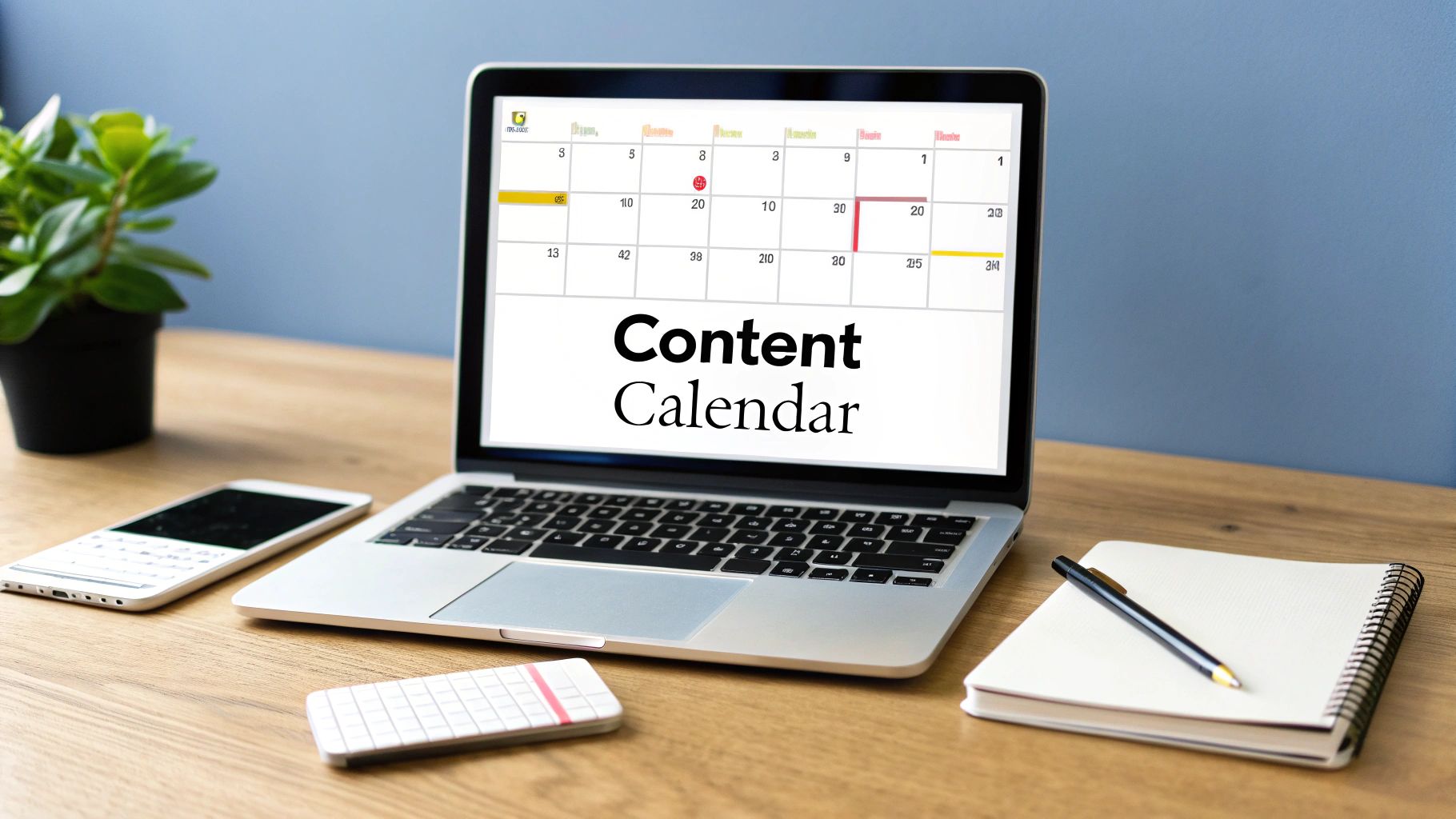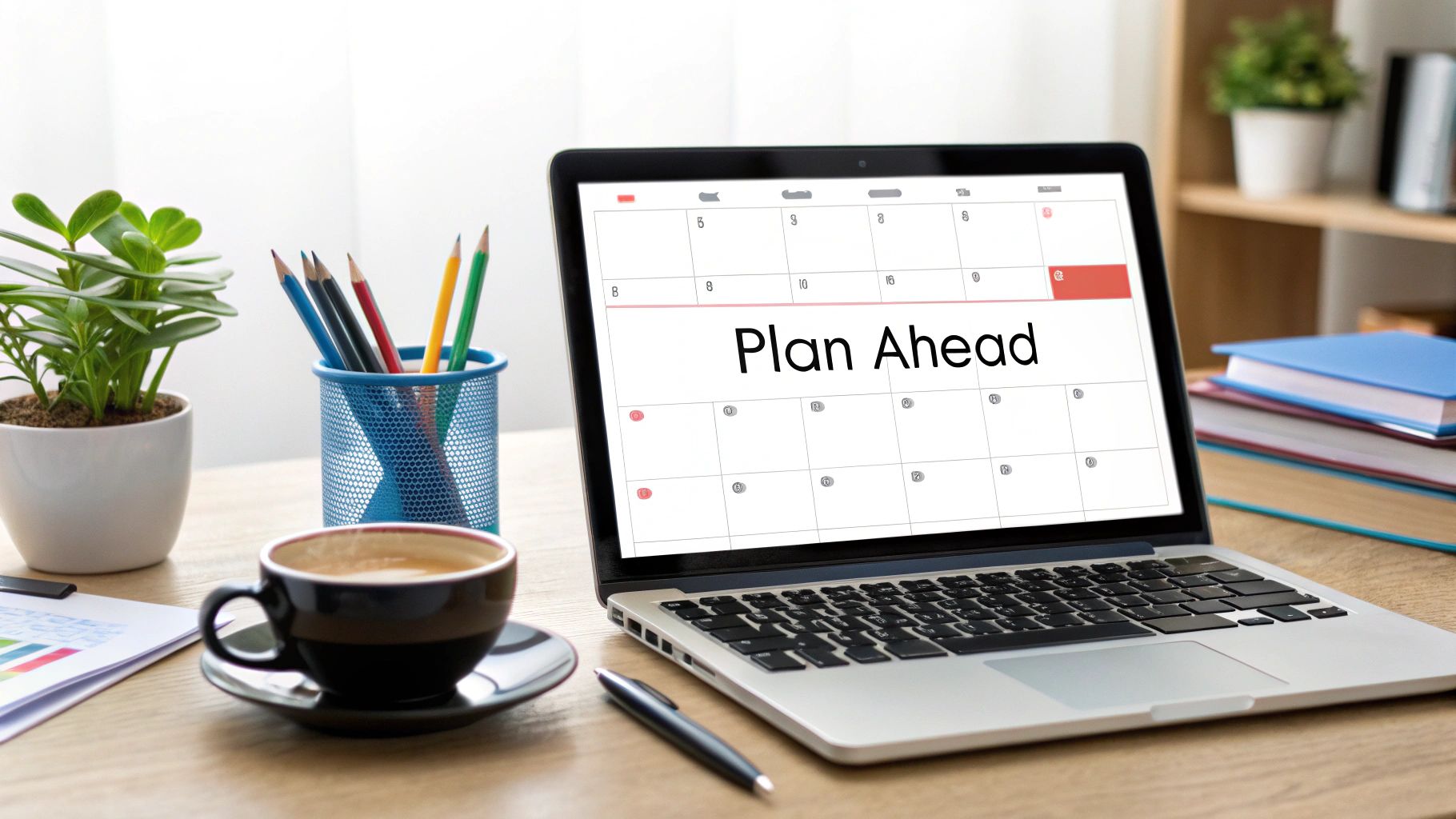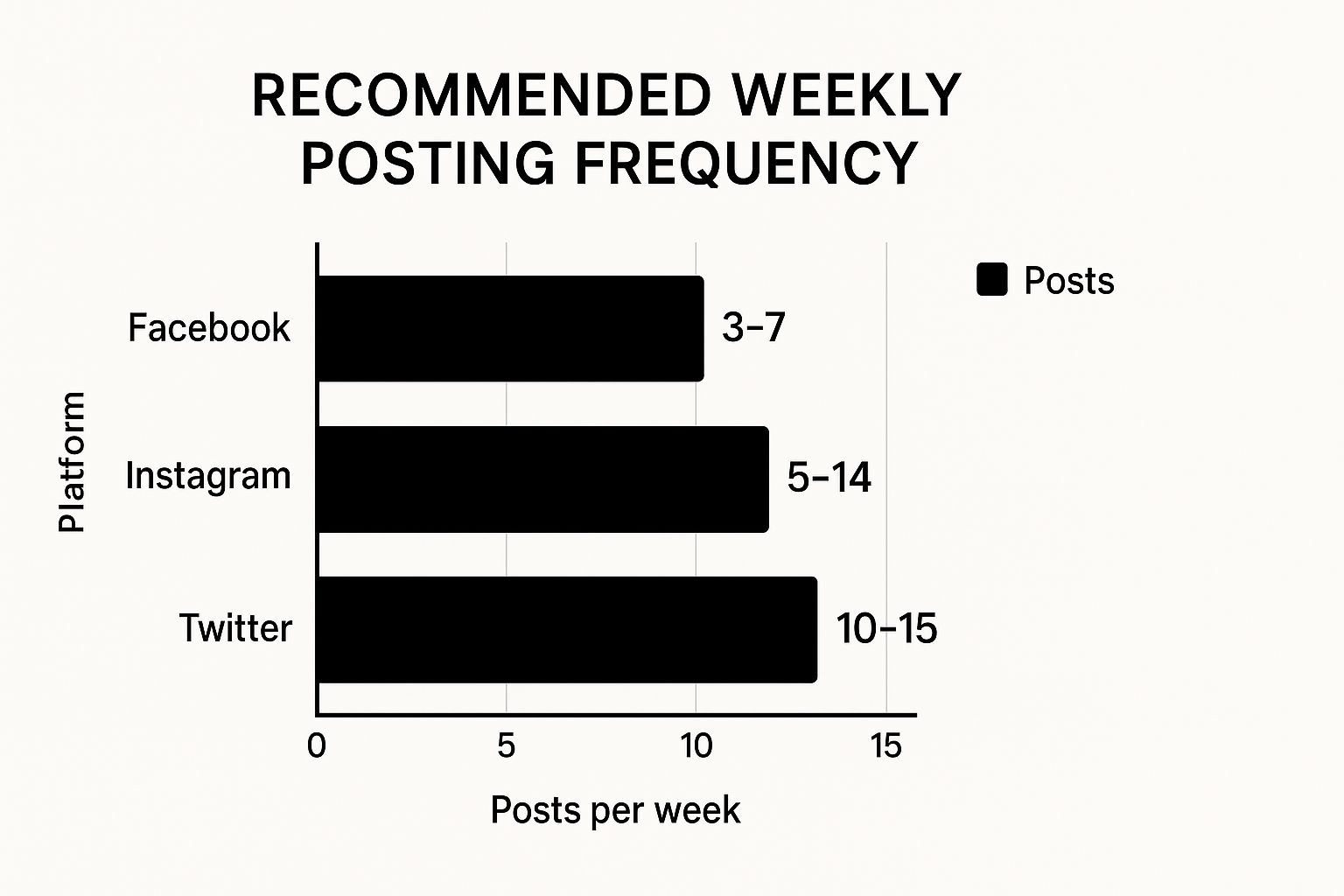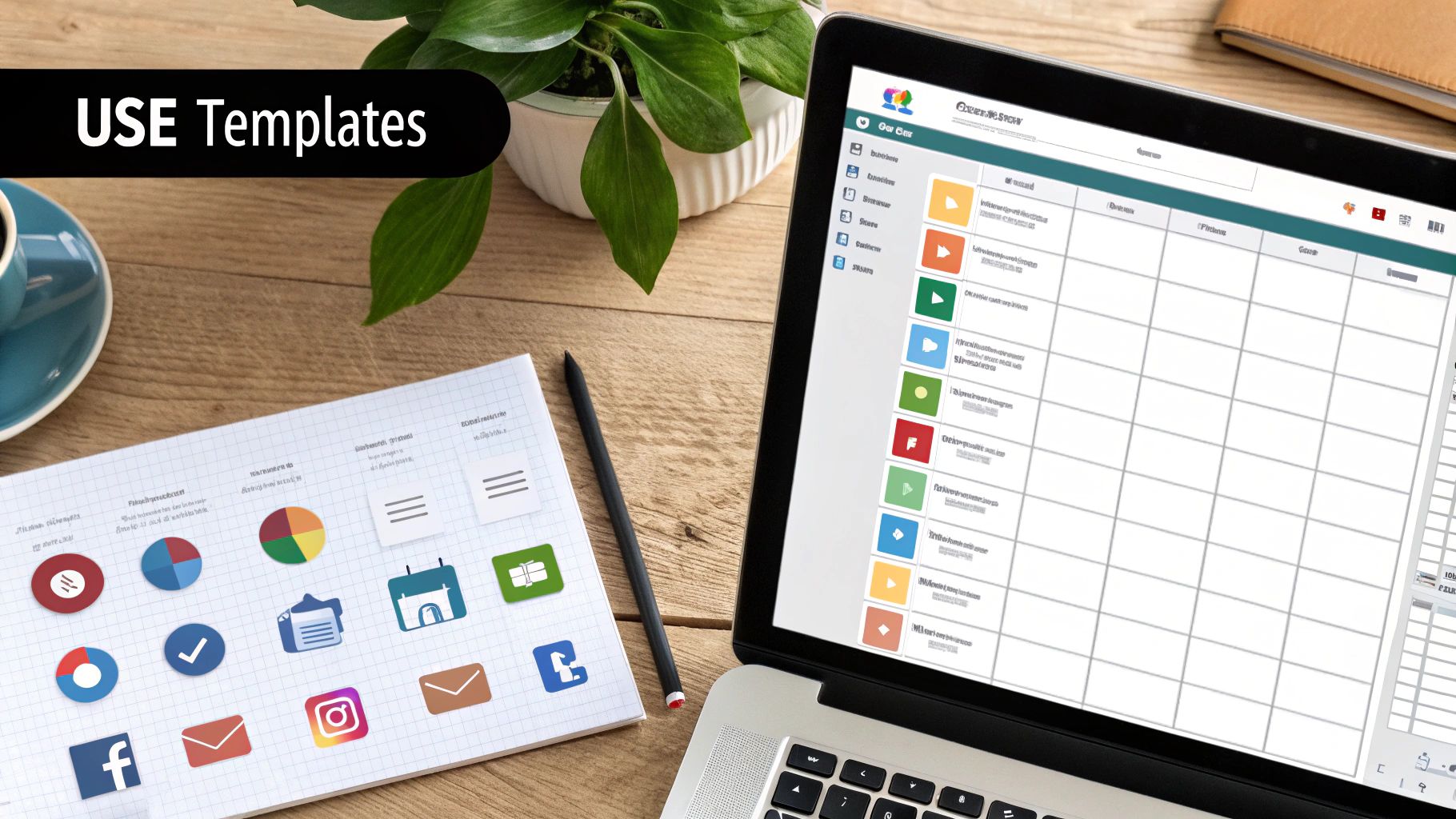
Build a Better Social Media Content Calendar
Stop guessing and start planning. This guide shows you how to build a social media content calendar that saves time, boosts engagement, and drives real growth.
Table of Contents
A social media content calendar is essentially your master plan. It’s a detailed schedule of all your upcoming posts, neatly organized by date, platform, and even the time you’ll post. Think of it as a strategic roadmap that turns random posting into a focused, goal-driven plan that actually saves you time and keeps you consistent.
Why Your Social Media Needs a Real Plan
Let's be honest—posting on the fly is chaotic. One minute you're desperately searching for an image, the next you're staring at a blank caption box with no idea what to say. That kind of reactive approach isn't just stressful; it's a terrible way to build a brand.
A solid social media content calendar is what pulls you out of that cycle. It shifts your entire strategy from reactive to proactive, giving you back control and a clear sense of direction.
This isn't just a "nice to have" anymore. With roughly 65.7% of the world's population now on social media, the competition for attention is fierce. The average person scrolls through nearly 6.84 different social networks every month, which means a unified plan is non-negotiable if you want to manage your brand's presence effectively. You can dig into more of these social media marketing statistics to really see the scale of it all.
From Daily Stress to Strategic Success
A content calendar completely removes that daily "what do I post?" panic. When you plan ahead, you can batch your work—write all your captions for the week, design the graphics, and even generate a whole folder of AI images with a tool like YourAIPhotographer in one focused session. It’s a simple change that can save you hours every single week.
Instead of reinventing the wheel every morning, you just follow the plan. This frees you up to focus on the things that actually move the needle, like engaging with your community and analyzing what's working. For a deeper look at what drives real growth, check out our guide on how to grow Instagram followers.
Guarantee a Consistent Brand Voice
Things get messy fast when more than one person is posting to your accounts. How do you keep the tone and style consistent? A shared calendar acts as the single source of truth for your whole team.
It gets everyone—from the copywriter to the graphic designer—on the same page about messaging, tone, and visual identity. That kind of consistency is what builds brand recognition and, more importantly, trust with your audience.
A content calendar isn't just a schedule; it's a strategic document that aligns your team, clarifies your message, and turns your social media channels into predictable assets for business growth.
Capitalize on Key Moments
With a calendar, you can see the bigger picture. Holidays, industry events, and product launches are no longer last-minute emergencies. They become planned-out campaigns.
You can prepare themed content, schedule promotions, and build genuine anticipation weeks in advance. This foresight is what separates the brands that just post from the ones that truly connect with their audience and drive results.
Building Your Calendar Foundation
Before you even think about what to post next Tuesday, we need to take a step back. A truly effective social media content calendar isn't just a grid of dates—it’s the end result of a smart, well-defined strategy. Without this groundwork, you’re just throwing content at the wall and hoping something sticks.
First things first: what does "success" actually look like for your brand? Vague goals like "get more followers" won't get you very far. You need to set real, measurable objectives that connect directly to your business goals.
Setting Clear Social Media Goals
Your goals are your north star; they'll guide every single piece of content you create. Are you trying to get more people to a new product page, or is your main focus on building a loyal community on Instagram? Each of those goals demands a completely different content strategy.
Let's get specific. Good goals look something like this:
- Increase qualified leads from LinkedIn by 15% this quarter.
- Boost our engagement rate on Instagram Reels by 20% over the next 60 days.
- Drive 500 clicks to our latest blog post from Facebook within the first week of publishing.
See the difference? These targets give your content a clear purpose and make it incredibly easy to track what’s actually working.
Auditing Your Existing Content
Next up, you need a clear picture of where you’re starting from. Think of a content audit as a quick health check for your social media channels. It’s all about looking back at your past posts to see what worked brilliantly and what was a total flop.
Dive into your analytics and start asking the hard questions. Which posts sparked the most conversation? What topics fell completely flat? Did your videos crush it on Facebook but get ignored on X (formerly Twitter)? This data is pure gold because it tells you exactly what your audience wants to see from you.
Don’t get distracted by vanity metrics like likes. Instead, zero in on the data that actually connects to your goals—things like link clicks, shares, and saves. This is how you figure out what truly resonates with your audience and encourages them to act.
This process will also shine a light on any content gaps. You might realize you haven't shared any behind-the-scenes content in months or that it's been a while since you posted a customer testimonial. These are the insights that will help you build a much stronger calendar.
Pinpointing the Right Platforms
Trying to be everywhere at once is a classic mistake. The truth is, you don't need to be on every single platform. You just need to be on the right platforms—the ones where your ideal customers are already hanging out.
Your content audit will make this crystal clear. If your analytics show you're getting tons of engagement on Instagram but hearing crickets on X, you know exactly where to focus your time and energy.
A great way to see this focus in action is to look at how professionals position themselves. For instance, checking out different influencer media kit examples reveals how they highlight their strengths on the platforms where they have the most sway. You should adopt that same focused mindset for your own brand.
Here’s a simple visual to help you imagine how you might map out your content across the platforms you've chosen.

A simple layout like this ensures you're putting your resources in the right places and creating content that’s perfectly suited for each channel. Once you have your goals defined, your past content analyzed, and your platforms selected, you’ve built the solid foundation you need for a killer content calendar.
Designing Your Content Mix and Cadence
Okay, you’ve got your strategy sketched out. Now for the fun part: deciding what you’re actually going to post and how often. This is all about nailing your content mix (the types of posts you'll share) and your cadence (your posting schedule).
It’s tempting to just shout about your products, but that gets old fast. A balanced mix is key. I always tell clients to start with the 80/20 rule. It’s simple: 80% of your content should be genuinely helpful, entertaining, or inspiring. The other 20%? That’s for your promotions.
Stick to that, and you'll be building a real connection with your audience by providing value. Then, when you do drop a sales post, people are much more likely to listen.
Establish Your Content Pillars
Think of content pillars as the main topics your brand owns. They’re the 3-5 core themes you'll return to again and again. This isn't just about being organized; it's about building a recognizable identity and making content creation way easier on yourself.
Let's imagine you run a boutique coffee shop. Your pillars could look something like this:
- Bean Wisdom: Deep dives into coffee origins, brewing guides, and tasting notes.
- Life at the Shop: Behind-the-scenes glimpses of your baristas, the roasting process, and the daily hustle.
- Community Hub: Highlighting regulars, promoting local events you're sponsoring, and shouting out other local businesses.
- Fresh Drops: Announcing new seasonal drinks, special-edition beans, or cool new merch.
See how that works? You’ve instantly created a framework that keeps your feed interesting and on-brand. This is a huge part of learning how to create engaging social media content that people actually want to follow.
To keep things fresh and strategic, it helps to map these themes across the week.
Sample Weekly Content Theme Breakdown
Here’s a simple table to show how you might spread out your content pillars to hit different goals throughout the week.
| Day of Week | Content Theme | Example Post Idea | Goal |
|---|---|---|---|
| Monday | Educational Sips | "3 Common Mistakes When Making Pour-Over Coffee" | Build Authority |
| Tuesday | Behind the Counter | A quick video introducing your newest barista. | Humanize Brand |
| Wednesday | Community Brews | Photo of a regular customer with their favorite drink. | Build Community |
| Thursday | Product Spotlight | Stunning AI image of your new "Pumpkin Spice Cold Brew." | Drive Sales |
| Friday | Behind the Counter | Time-lapse of the morning rush. | Boost Engagement |
| Saturday | Educational Sips | Carousel post on the difference between Arabica and Robusta. | Provide Value |
| Sunday | Community Brews | "What's everyone up to this weekend? Stop by for a refuel!" | Spark Conversation |
This kind of planning ensures you’re not just posting on a whim but are being intentional with every single piece of content.
Figure Out Your Posting Frequency
"How often should I post?" I get this question all the time. The honest answer? It depends. It varies by platform, by industry, and by what your own audience data tells you. Don't fall into the trap of posting daily just for the sake of it.
Consistency will always beat frequency. It's so much better to share three fantastic, well-crafted posts a week than to scramble and push out seven mediocre ones. Start small, get your rhythm, and then scale up.
Not sure where to begin? This chart gives some solid general guidelines for posting frequency on the big platforms.

Think of this as your starting point, not the final word. Your analytics are the real source of truth here.
Tune Your Cadence to Your Industry
Finally, remember that every industry moves at a different speed. A B2B software company isn't going to have the same posting rhythm as a fast-fashion brand, and that's okay. Your calendar needs to reflect your sector's norms.
For example, data from Hootsuite shows consumer goods brands are super active on Facebook, posting an average of 9.0 times per week. Meanwhile, the restaurant and hospitality world practically lives on Instagram, with an average of 11.9 posts a week.
This is why a one-size-fits-all schedule just doesn't work. By defining your content pillars and setting a realistic cadence based on data, you turn that blank calendar into a roadmap for real growth.
Choosing the Right Tools for Your Workflow

A great strategy is nothing without the right tech to back it up. Let's be honest, even the most perfectly planned content calendar can become a huge headache if your tools are clunky and hard to manage. The goal here isn't to find the one "best" tool, but to build a smart tech stack that actually fits how you work, the size of your team, and your budget.
Lots of people start out with a simple shared Google Sheet, and there's absolutely no shame in that. It’s free, you can customize it endlessly, and it works surprisingly well for collaboration when your process is still fairly simple. You can easily set up columns for dates, platforms, copy, visuals, and an approval status. It's a powerful and practical starting point.
But what happens when your team gets bigger or your content strategy gets more sophisticated? You'll probably start feeling the limitations of a spreadsheet. That’s the cue to look into dedicated project management tools or social media schedulers.
Upgrading Your Calendar Management
When you need more structure, platforms like Asana or Trello are fantastic. They turn your calendar from a static grid into a living, breathing workflow. You can create a "card" for each post, assign it to a team member, attach deadlines, and watch it move across the board from "idea" to "published." It’s a game-changer for team visibility.
If you’d rather combine your planning and publishing into one platform, then tools like Hootsuite or Planable are the logical next step. They give you powerful calendar views, let you schedule everything in advance, and even offer analytics to see what’s working. They handle the tedious, repetitive task of manually posting, which frees you up for more important things like strategy and creative brainstorming.
The right tool isn't about having the most features; it's about reducing friction in your creative process. If a tool saves you time and keeps your team aligned, it's worth its weight in gold.
Integrating AI as Your Creative Partner
Beyond just organizing and scheduling, the real magic happens when you bring AI into your workflow. Modern AI tools can be incredible creative partners, helping you smash through common content creation roadblocks. Stuck on a caption? An AI writer can spit out a handful of great options in seconds.
This is especially true when it comes to visuals. We all know that creating unique, high-quality images for every single post is a massive drain on time and money. This is where a tool like YourAIPhotographer becomes your secret weapon. Instead of scrolling through endless stock photos, you can generate perfectly on-brand, photorealistic images that are tailored to the exact post you’re creating. Imagine knocking out an entire month's worth of custom visuals in a single afternoon.
Here’s a quick look at how AI can seriously upgrade your content calendar:
- Visual Generation: Create one-of-a-kind images for promotions, blog post headers, or daily content without ever booking a photoshoot.
- Caption and Copy Ideas: Beat writer's block for good by generating multiple hooks and caption ideas for any topic.
- Trend Spotting: Some tools can even analyze data to help you catch emerging topics or trending audio before everyone else does.
By building a tech stack that includes a solid calendar tool and a smart AI assistant, you streamline your entire process from start to finish. If you want to see just how powerful this combination can be, you should explore some of the best AI content creation tools available today. This approach lets you automate the boring stuff, leaving you more time for what really moves the needle: creativity and strategy.
Turning Your Calendar into a Growth Engine

It’s easy to fall into the trap of treating your social media content calendar like a static document. You spend hours filling it up, you schedule everything out, and then you just… let it run. But the real magic happens when you see it as a living, breathing tool for growth—less of a rigid schedule and more of a strategic blueprint that you can constantly refine.
Think about it: the most successful brands on social media don't just talk at their audience; they talk with them. This means your calendar needs to have some wiggle room. While scheduling your core posts is crucial for staying consistent, you have to leave space for those real-time marketing moments that you just can't predict. I’m talking about trending memes, sudden industry shake-ups, or viral challenges that pop up out of nowhere.
Make Room for Spontaneity
So, how do you plan for the unplanned? You build "flex days" or open slots directly into your weekly schedule. This is your dedicated time to react.
When you see a trend exploding that perfectly matches your brand's personality, you already have a spot carved out to jump on it. This way, you can be part of the conversation without scrambling and throwing your entire strategy into chaos.
Your content calendar shouldn't just be about what you're going to say. It should also be about when you're going to listen. Building in time for engagement and real-time reactions is what turns a simple schedule into a relationship-building machine.
This approach keeps your feed from feeling stale or robotic. It proves to your followers that there's a real person at the helm who’s paying attention to what's happening right now, not just an algorithm churning out pre-made content.
Schedule Your Community Management
Engagement shouldn't be an afterthought you squeeze in when you have a spare five minutes. It’s a core task that needs a dedicated spot on your calendar. If you’re serious about building a loyal community, you have to show up for them consistently.
True community management is so much more than just replying to comments on your own posts. It's an active, ongoing effort that includes:
- Active Listening: Deliberately searching for mentions of your brand—both tagged and untagged—and jumping into relevant conversations.
- Engaging with User-Generated Content (UGC): Actively finding, commenting on, and sharing posts from customers who are using and loving your products.
- Outbound Engagement: Interacting with content from other accounts in your space, whether they're potential collaborators or just your biggest fans.
By blocking out time to monitor brand mentions and industry chatter, you can provide quick feedback, answer questions, and build genuine trust. This is the difference between just publishing content and actually building relationships.
This proactive management is also fundamental if you want to understand how to monetize social media. Strong community bonds directly translate to customer loyalty and, ultimately, sales. When you transform your calendar into a plan for both posting and engaging, you create a powerful engine for real, sustainable growth.
Common Questions About Content Calendars
Even with the best strategy in hand, a few questions always seem to come up when you start building and managing a social media calendar. Let's walk through some of the most common ones I hear, so you can sidestep those roadblocks and keep your workflow smooth.
A big one is always, "How far ahead should I actually plan?" For your everyday, core content, aiming for about one month in advance is a great sweet spot. It gives you and your team plenty of breathing room for creation, approvals, and any last-minute tweaks. This way, you're not scrambling, but you're also not so locked into a rigid plan that you can't adapt.
Of course, that changes for the big stuff. If you're gearing up for a major product launch or a huge holiday campaign, you’ll want to extend that runway. I’d recommend planning those out two to three months ahead of time.
How Do I Find Enough Content Ideas?
Staring at a blank calendar can be intimidating. The fear of running out of ideas is real, but keeping the well full is easier than you might think. Your best source is right in front of you: your audience.
What are they asking in your DMs and comments? Every single question is a potential post just waiting to be made.
And don't forget the magic of repurposing. One deep-dive blog post can be sliced and diced into so many different things:
- A helpful carousel post for Instagram.
- A quick, attention-grabbing video for Reels or TikTok.
- A series of bite-sized tips for X or LinkedIn.
This approach lets you get way more mileage out of every piece of content you create. Another fantastic way to fill your calendar while making your community feel seen is by featuring user-generated content.
My best advice? Always leave a few empty slots in your calendar each week. That flexibility is your secret weapon. It lets you jump on a trending sound, share a spontaneous behind-the-scenes look, or weigh in on breaking industry news.
What Are the Best Free Tools for a Content Calendar?
You absolutely do not need to break the bank on fancy software to stay organized. There are some incredibly powerful—and free—tools out there that work wonders.
For a completely custom, no-frills approach, you can’t go wrong with Google Sheets. If you’re more of a visual planner, check out project management tools like Trello or Asana. Their free plans are more than enough to get you started, using Kanban boards to drag and drop post ideas from "To-Do" to "Done."
Many scheduling tools like Buffer and Later also offer free plans that come with a basic calendar view, which is perfect if you’re only managing a handful of social profiles.
Ready to create stunning, unique visuals for your content calendar without the hassle of a photoshoot? YourAIPhotographer lets you generate photorealistic images in seconds. Train your AI model and start creating unlimited on-brand photos today at https://youraiphotographer.com.
